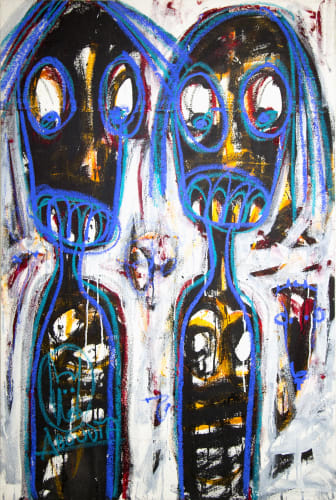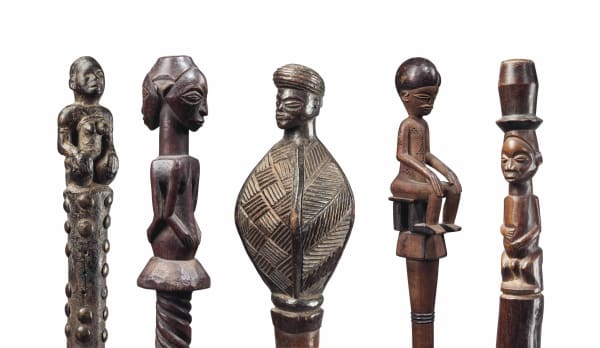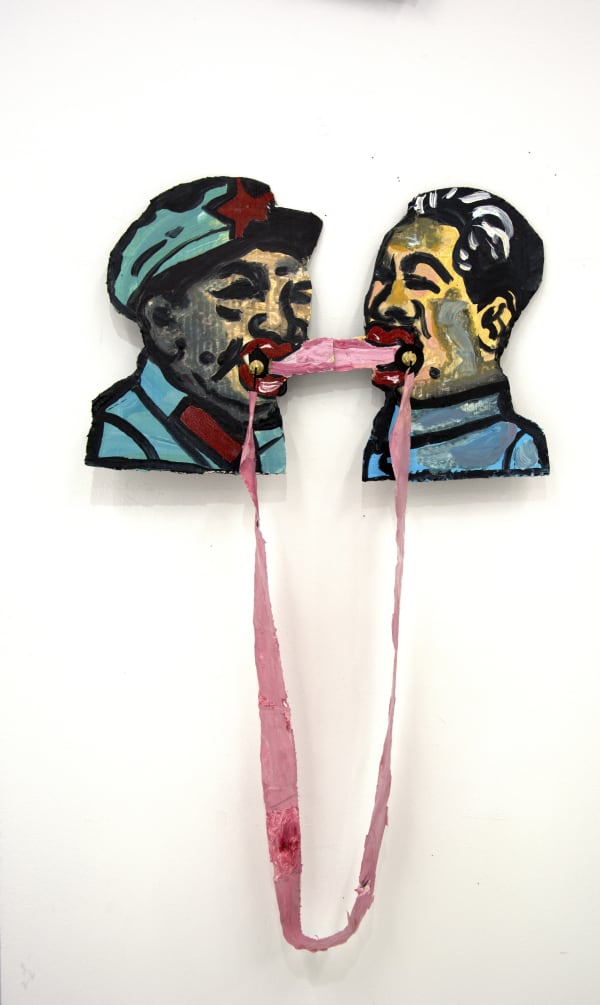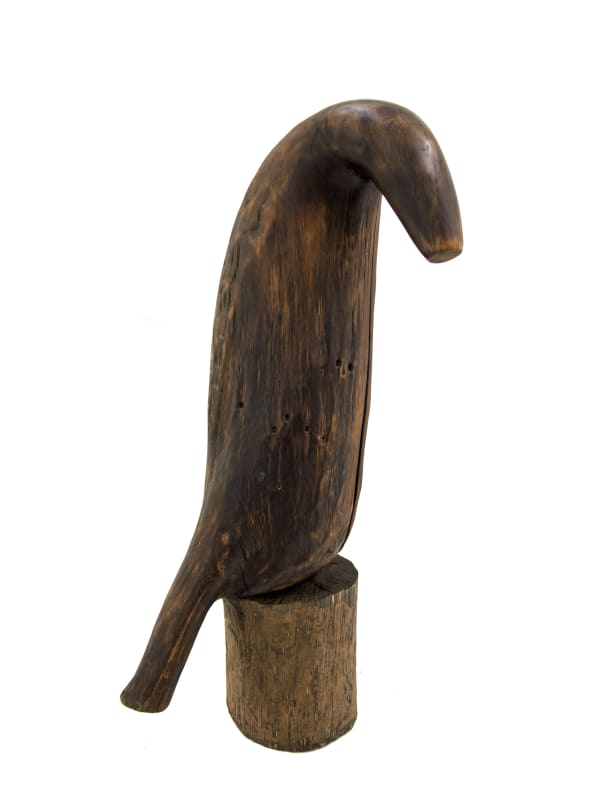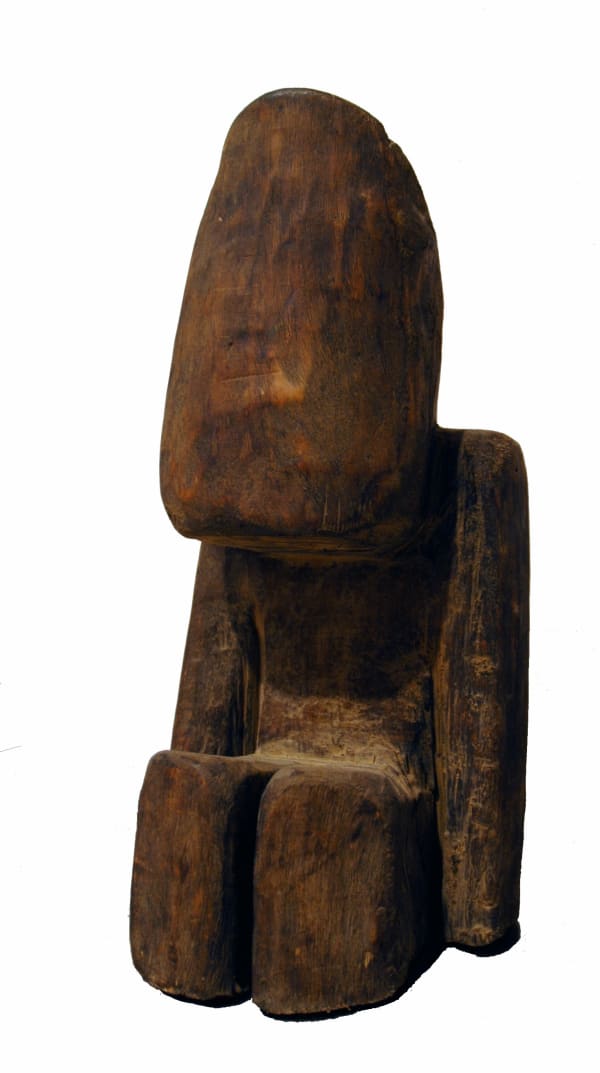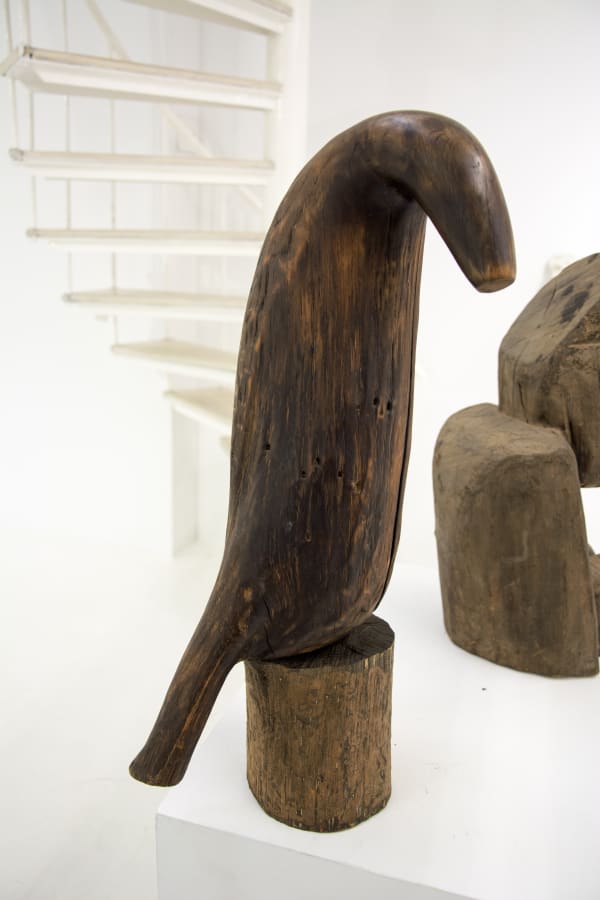Abstraction, Tradition, Time, and Totems: A Group Exhibition
Ethan Cohen Gallery is pleased to present Abstraction, Tradition, Totems, and Time, its first group exhibition of the fall 2020 season. This exhibition features works from variegated artists from diverse backgrounds, brought together by the themes of abstraction, tradition, the passage of time, the spirit of the object, and more broadly, the spirit of expression.
Featured artists:
Aboudia
Ushio Shinohara
Wang Keping
Jeannie Motherwell
Emil Alzamora
Jeffrey Hargrave
Zhang Yanzi
Bailey Bob Bailey
Lan Zhenghui
Qin Feng
Mina Cheon
Bailey Bob Bailey
Kim Chun Hwan
Ryoga Katsuma
Gabriel Shuldiner
Unknown Tribal Artists
ABOUDIA
b. 1983, Abidjan, Ivory Coast
Aboudia's multi-layered paintings offer simultaneity of images and meanings that conduct a continuous discourse with each other and with the viewer. In any glance, the eye takes in one or another layer, which is soon overcome by the next. We are aware of the vivid, brutal pageant of contemporary Africa weaving before us like a fabric of consciousness - soldiers, skulls, African fetishes, flashes of street life - expressed with vitality. The surfaces deploy fragments, cuttings, from bits of comic strips, magazine ads, newspaper images, set into the paintings' overall compositions so as to suggest current events cohering through the imagination into a troubled and troubling vision.
In the end though, the artist's gift of cohesion transforms chaos into vitality, painful events to esthetic redemption, so one is able to see the whole as a changeable tide forever renewing hope.
USHIO SHINOHARA
Lives and works in Brooklyn, NY
1932 born in Tokyo, Japan
Shinohara pioneered the ephemeral art form of using physical action to create paintings. According to curator Reiko Tomii, “…this distinguished Shinohara from other artists like Jackson Pollock, George Mathieu and Gutai’s Shiraga Kazuo, who also used action to create paintings.” Shinohara’s pursuit of “pure action” distinguished him as not only a painter but also a performance artist.
Shinohara was a major player in the groundbreaking Tate Modern exhibition, “The World Goes Pop”. Curator Reiko Tomii writes, “No other artist better exemplifies the essence of Pop in Japan than Ushio Shinohara,” and describes Shinohara as one of the central figures of Anti-Art, through which his Boxing Paintings were devised. Shinohara was also a leading artist in “Tokyo 1955-1970: A New Avant-Garde” at The Museum of Modern Art. His work has been widely exhibited internationally at institutions including Centre Geroges Pompidou, the Hara Museum of Contemporary Art, the National Museum of Modern Art, Tokyo, The Metropolitan Museum of Art, Seoul, The Guggenheim Museum SoHo, Leo Castelli Gallery, New York, Museum of Contemporary Art, Los Angeles, and others. Shinohara, with his wife Noriko, is the subject of the documentary film “Cutie and the Boxer” (2013).
WANG KEPING
Born 1949 in Beijing, China
Lives and works in Paris, France
Wang Keping was one of the founders of the non-conformist artist group "The Stars" (Xing Xing), formed in 1979 during the post-Cultural Revolution "Beijing Spring". This group of young avant-garde artists challenged the status quo and were pivotal in initiating some of the first free art expressions in the post-Mao era bringing together like-minded artists as Huang Rui and Ma Desheng. As one of France and China's foremost sculptors, Wang Keping's sculptures are an exploration of the human form. With a natural intuition of space and balance, they convey a highly sensual representation of the female body, mother and child. Wang Keping reveals the natural contours of the wood: the grain; knots; and flaws to evoke figurative representations in his work. Inspired in his early years by masters of European Modernist sculpture.
Wang Keping was born in Beijing in 1949. In 1979, he took part in the Beijing Spring Democracy Movement. He is a founder of the Stars Group (Xing Xing), China's first avant garde art group following the Cultural Revolution. In September 1979, The Stars Group (Xing Xing) organized the first non-conformist art exhibition on the gates of the National Art Museum of China in Beijing. It had a great impact in China. He has been living and working in Paris since 1984.
JEANNIE MOTHERWELL
b. New York City
Born and raised in New York City, Jeannie Motherwell inherited a love of painting from her father, Robert Motherwell, and stepmother, Helen Frankenthaler, two pillars of mid-century abstraction. She studied painting at Bard College and the Art Students League in New York. Continuing with her art after college, she became active in arts education at the Bruce Museum in Greenwich, CT, until relocating to Cambridge, MA, where she worked at Boston University for the graduate program in Arts Administration until 2015. She served on the Cambridge Arts Council Public Art Commission from 2004 - 2007 and is currently on the Advisory Board for Joy Street Artists Open Studios in Somerville, MA. Her work has been featured in public and private collections throughout the US and abroad.
JEFFREY HARGRAVE
1973 born in Salisbury, N.C Jeffrey Hargrave is a North Carolina born, African-American artist based in New York. Hargrave deals with representations of African-Americans, often putting them in the context of art history, remaking works by artists such as Matisse to include black figures, with racially charged stereotypical imagery.
Tapping into his own memories of growing up in the midst of a sharply divided community, Hargrave translates his personal experiences into playful, yet biting images that mix art-history clichés and racial stereotypes. Ultimately, the artist seeks to engage viewers in a dialogue on class, religion, sexuality, racial identity and privilege based on a repertoire of familiar images.
Hargrave attended the University of the North Carolina School of the Arts, Rhode Island School of Design and Skowhegan School of Painting and Sculpture. His works have been exhibited at the Bronx Museum of the Arts, and other prestigious venues.
ZHANG YANZI
Zhang Yanzi was born in Zhenjiang, Jiangsu Province. Graduated from the Central Academy of Fine Arts, Zhang got her MFAs in both Chinese Painting and Literature. She is currently based in Beijing and she works at the Central Academy of Fine Arts and serves as an advisor for graduate students. Her solo exhibitions were held respectively at Shanghai Art Museum, Today Art Museum, PAN, Palazzo delle Arti di Napoli, Hong Kong Museum of Medical Sciences, Surgeons’ Hall Museums, and Museum of East Asian Art (ME-AA). Her works have been included in the collections of numerous art institutions and private collections.
For her latest body of work Lost Again, Zhang Yanzi adopts the material of analgesic plasters that she usually uses to cover fluorescent tubes. Drawing on an experimental ink practice, Zhang has created a deconstructed landscape painting that has been portrayed on analgesic plasters, to represent tradition, humanity, and poetic expression. Light shines through the small holes of analgesic plasters, conveying hope and strength in the human soul. Upon observation, stories of time seem to be flowing out from these glittering “living organisms.”
LAN ZHENGHUI
1959 born in Sichuan, China
Occupying the esthetic confluence between traditional Chinese ink painting and Western abstract expressionism, Lan Zhenghui’s work reinvents both. He lets the ink follow and discover its own momentum in bold, kinetic, strokes. He has liberated ink from being determined by form. But the spirits of Chinese landscape linger like ghosts in the canvas. They haunt both the process – the brushstrokes, the vectoring – and the resulting shapes. Mountains, rivers, storms, even figures, surge and evaporate subliminally. It was said of the Fauvists and Matisse that they had liberated color from the imperatives of form tantamount to Lan's accomplishment with ink.
Lan Zhenghui was born in 1959 in Sichuan, China. He graduated from Sichuan Fine Arts Institute in 1987, and currently lives and works in Beijing, China. His work has been collected by museums, universities, and is part of private collections.
QIN FENG
Born 1961, Xinjiang Province, China
Qin Feng is a leader of contemporary ink painting and a forerunning representative of the Chinese avant-garde art movement. Qin studied at Shandong University of Art and Design, and later moved to Berlin, Germany, and then the United States. His paintings experiment with traditional Chinese ink painting and Western abstract expressionist styles, maintaining a link with the traditional while toying with the imported. His use of tea, which represents the East, and coffee, the West, in the backgrounds of his ink paintings emphasizes cultural contrasts and his attempt to bring the two together.
Qin’s upbringing in Xinjiang, located in the extreme northwest of China, profoundly influences his work. Once an intersection for Silk Road trade routes, Xinjiang historically has been a center for multicultural and multiethnic coexistence, making Xinjiang a unique locus for different languages including Chinese, Arabic, Uighur, and Hindu. Qin’s childhood in Xinjiang, and later his travels abroad, exposed him to varying cultures and languages, resulting in his present fascination with written and spoken word, systems of universal communication, and cultural difference.
MINA CHEON
b. 1973 Seoul, South Korea
Mina Cheon (PhD, MFA) is a Korean-American global new media artist, scholar, and educator who divides her time between Korea and the United States. Cheon has exhibited her political pop art known as “Polipop” internationally and draws inspiration from global media and popular culture to produce work that intersects politics and pop art in subversive and provocative ways. In particular, Cheon has worked on North Korean awareness and global peace projects since 2004 and appeared to the world as a North Korean artist KIM IL SOON since 2013. While she creates work that range in medium from new media, video, installation, performance, and public projects to traditional media of painting and sculptures, the content of the work is in historic alignment to appropriation art and global activism art.
Just as the Korean peninsula is split, so is its contemporary artistic consciousness. Mina Cheon is a South Korean artist who collaborates with her North Korean alter-ego KIM IL SOON (a Socialist Realist painter, naval commander, farmer, scholar, teacher, mother, and human being). In this, the latest of Cheon’s grapplings with the Korean schizo-imaginary, the topics of art, motherhood, games and hope come together in a reflection upon (cult)ure, love and education.
Cheon has worked with underground networks to send hundreds of USB drives containing performance lectures on contemporary art history into North Korea – arguably the first such artistic ‘re-programming’ engagement with the nation to date. The Art History Lessons by Professor Kim (2017) endeavor to be relatable for North Korean and American audiences – borrowing from children’s TV show formats while showcasing today’s contemporary artists and critical perspectives. Carrying the vital messages “The world loves you, North Korea” and “Both art and lives matter”.
RYOGA KATSUMA
1979 born in Kochi, Japan
Katsuma’s career as an artist started on the streets of Osaka. He felt sick of boring country life, and he had run away from his home in Katashima Island, Kochi. At that time, he was a teenager, and started to live on the streets of Osaka as a homeless person. He had no money to buy food, but tried to think hard about how to get money and survive. As a result, he bought a pen and notebook, and started to draw the portraits of passersby. At first, his drawings were awful, but people liked Katsuma’s funny character, and started to buy his drawings and give him food. He started to enjoy drawing, and started to think about becoming a professional painter. This is an anecdote about why Katsuma started his career as a professional painter.
KIM CHUN HWAN
b. 1968
Kim’s work repurposes the paper advertisements and letters that all too often fill our lives. The bombardment of consumerist stimuli is manipulated to create ornate textures and patterns. Each piece of paper, with its fold, color, and text has its place amid the layers. The depth and scale of Kim’s works are remarkable testaments to the depth and scale of available material for his artistic practice. Kim’s works are extraordinary displays of a transient reality otherwise ignored. Kim Chun Hwan currently lives and works in France. Kim holds a B.A.L Fine Arts from Seoul National University, and his work has predominantly been shown in Europe since 1999.
UNKNOWN TRIBAL ARTISTS
The five staffs included in this exhibition are from different tribes in the Congo and Angola, all originally serving as a staff of authority. The grouping includes an exquisite staff from the Congo with a crouching female figure, a Hemba staff with a twisted handle with an anthropomorphic Janus figure, the two Lwena canes – one adorned with a head and decorative carving, and one with a seated figure, and lastly a staff most likely sculpted by a Suku artist.
EMIL ALZAMORA (b. 1975 in Lima, Peru)
Alzamora harnesses a wide range of materials and techniques to deliver unexpected interpretations of the sculpted human figure. He often distorts, elongates, deconstructs, or encases his forms to reveal an emotional or physical situation, or to tell a story. Alzamora's keen interest in the physical properties of his materials combined with his hands-on approach allows for the process to reveal and inform at once the aesthetic and the conceptual.
BAILEY BOB BAILEY
After studying sculpture at Virginia Commonwealth University, Bailey attended Skowhegan and was twice a fellow at The Fine Arts Work Center of Provincetown. He currently lives and works in Truro, MA. Bailey has shown extensively throughout the U.S. and internationally, most recently with Ethan Cohen Gallery in NYC and Beacon, NY ,and was a founding member of an artist-owned gallery, artSTRAND, and is now represented by The Schoolhouse Gallery in Provincetown, MA and Ethan Cohen Gallery in NYC/Beacon, NY
GABRIEL J. SHULDINER
Interested in the timeless and disparate associations assigned to black, Gabriel J. Shuldiner describes his work as ‘bruteminimalism®’: a concept situated somewhere between the abstract and absurd. His physically powerful, "s[r]seductively" delicate ‘hybridsculpturalpaintings®’ trigger both immediate engagement and visceral reaction, conjuring images of voids in space and post-apocalyptic futures. He sites the 'subtlety of difference, produced through repetition' and the 'implied nuanced histories of the oft-overlooked' as starting points for work that explores and disrupts 21st-century painting and object-making. Shuldiner deems his elusive black palette "postapocalypticblack®": a viscous custom composite, based upon the key life ingredient and oldest known earth element carbon [pigment]. applied in thick layers on a multitude of substrates, Shuldiner meticulously bends, scrapes and sculpts his proprietary black material, creating mysterious areas both smooth and rough that proportionately reflect, refract, distort, and absorb observable levels of electromagnetic radiation. His ongoing oeuvre examines the physical and psychological qualities of visual experience through the use of black paint.

